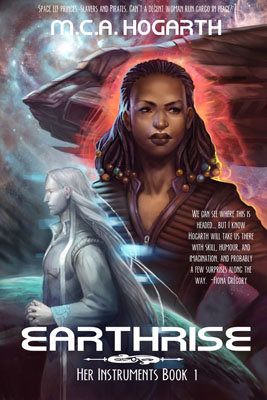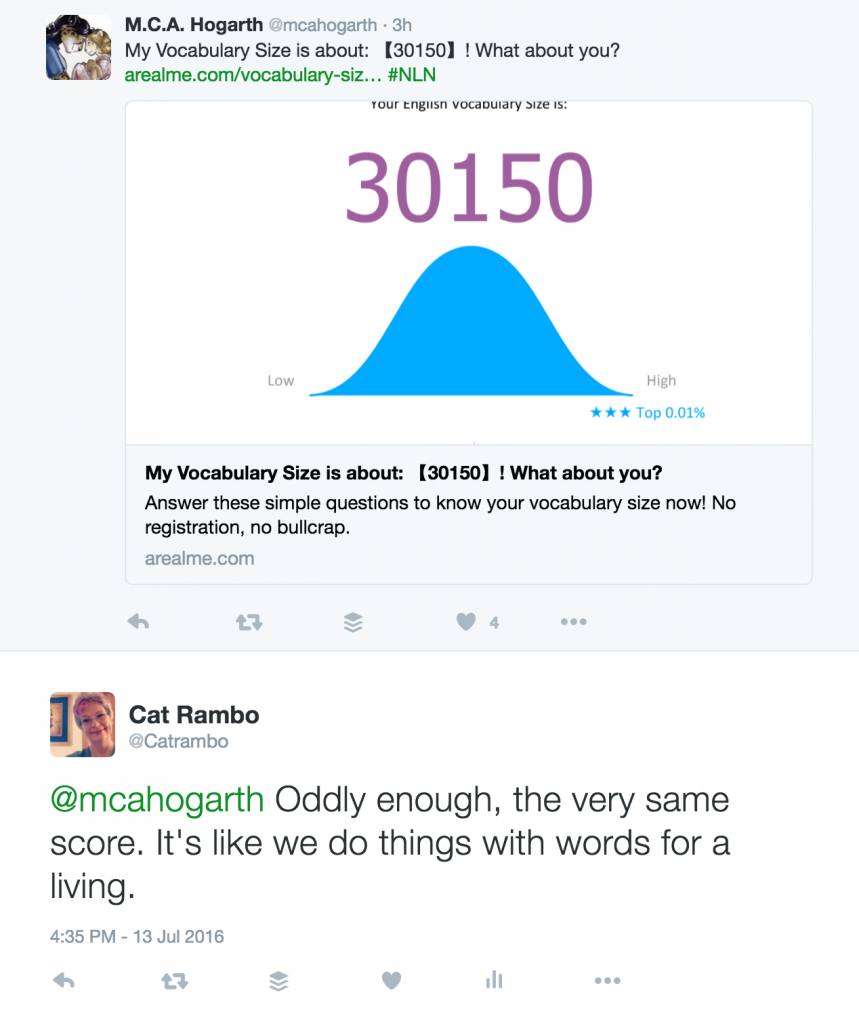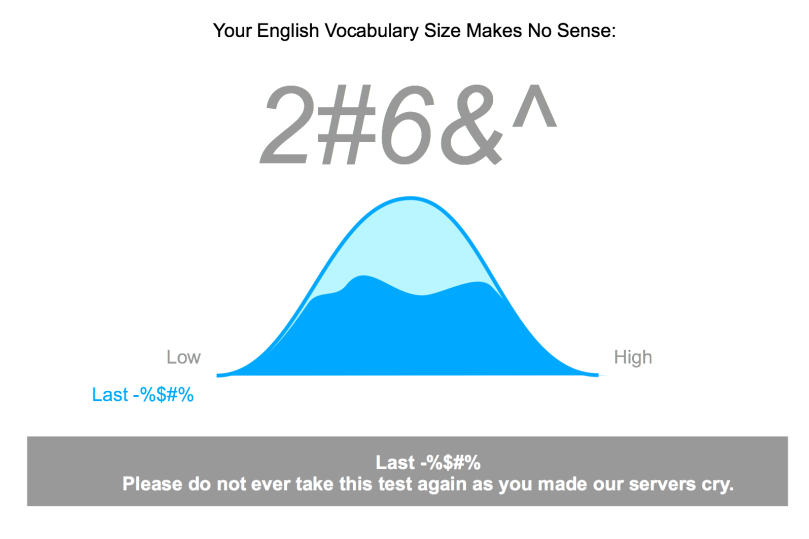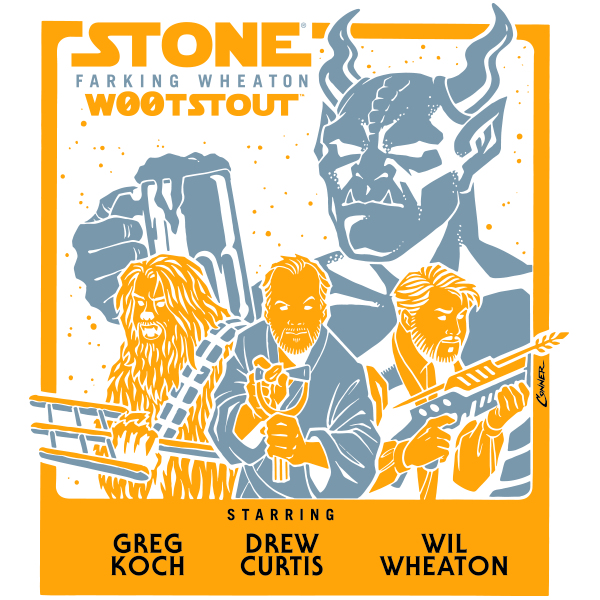By Carl Slaughter: M.C.A. Hogarth is a prolific author. Most of her stories are in the Pelted universe. She is also a fiction illustrator and illustrates her own stories. She also does coloring books and children’s books. She is a Kickstarter veteran and advises other authors on Kickstarting. Hogarth is VP of the SFWA.
CARL SLAUGHTER: Why are most of your series in the same universe?
M.C.A. HOGARTH: There’s a George Eliot quote that goes ‘How unspeakably the lengthening of memories in common endears our old friends!’ I love writing broadly and deeply in the same setting because it gives us—the readers, me—the opportunity to settle in, become more than tourists, develop a group memory. I now have multiple settings where my readers remember “historical” details, often before I do. We’re properly sunk in at that point, and that’s when you get community.
In the end, I guess I like people. You don’t come close to understanding a person without living with them for a while.
SLAUGHTER: Obviously, your fans like the Pelted universe. What’s the appeal?
HOGARTH: When I was super-young, I was deeply attracted to Star Trek for its optimism, and I thought ‘I want to make a world that people would want to live in.’ And so… I did. I populated it with friendly animal races, because who doesn’t love talking cats and foxes and giant birds? And then added fascinating aliens, because who doesn’t long to explore the unknown and find it welcoming? I gave it a noble war, so people could have a chance to defend the true and good. I made that war complex, so people could find ways to redeem evil. I made the universe expansive so that its potentials felt limitless. I made it nuanced, so people could find their own struggles in it. I added dragons and elves, because come on. Dragons. Elves.
It’s unashamed space opera, and I think just about everyone can find a place they belong in it. And it’s been in continuous development for over twenty years, so it feels like a real place to a lot of readers.
The Peltedverse is a refuge, and everyone can be a hero, whatever heroism means for them. I think that’s why a lot of people enjoy it.
SLAUGHTER: Which Pelted series is ideal for which type of reader?
HOGARTH: I chose to go with the “Valdemar”-style development of the Peltedverse, because I always felt it was easier to jump into a setting with several complete stories than trying to catch up to Book 24 in a single series. So, yes, there are multiple threads, and some of them are dark and some of them are bright. The war stories are the harshest, and those start with the Princes’ Game books (Even the Wingless is Book 1). The gentlest are the slice-of-life pastoral “college campus” stories of xenotherapists Jahir and Vasiht’h, which start with Mindtouch. Somewhere in the middle, in the action-adventure slot, are the books of the Her Instruments series, which starts with permafree Earthrise. There’s also a sleeper series about one of Fleet’s military crews, the Stardancer, that I’m starting to develop now. That’s going to have a more classic Trek feel (“new adventure every week”).
SLAUGHTER: You describe your Kherishdar stories as “genteel and meditative,” “dense and contemplative,” “provocative,” and “controversial.” What is it about these stories that justifies these descriptions?
HOGARTH: With Kherishdar I wanted to tackle the idea of a caste-based system that worked. This is a society where everyone has a proper place, and no, you don’t step outside it. We’re conditioned to think of that as appalling. But what conditions would apply, I wondered, to make it not so? What if they were right? Could I write that universe?
This is not a minor question, since every form of collectivism is blood-and-bone-anathema to me, from a familial history perspective.
So I embarked on this experiment (via crowdfunding—my readers paid for all 50 pieces of flash fiction in my original plan) and discovered that, yes, yes I could imagine a world where this worked. And it was profoundly uncomfortable to contemplate that world unless you immersed yourself in it, and its mindset. This is part of the reason I started developing its language so fully, so that we could “speak” the language and see what it did to us. The two flash fiction chapbooks led to a full-length novel (Black Blossom) about the power of negative ideas and how cultures can fail to intersect productively.
It’s worked out well enough that I’m serializing a new novel via Patreon. It’s a pleasure to have so many of my Ai-Naidari fans back (and using my own vocabulary to comment on events as they unfold!).
SLAUGHTER: Compared to your other fiction, the Kherishdar series seems much more message oriented than entertainment oriented. Lots of sociology and philosophy. Like a parable. What are the lessons we humans can learn from these other species?
HOGARTH: I’m not sure anything I write is intentionally message-oriented, honestly. At least, it doesn’t come from a place where I want to lecture. I like using fiction to explore ideas and thoughts that would otherwise trouble me, or intrigue me: it’s a safe place to do that, and I invite my readers to come see what happens. But the ‘what happens’ is always the paramount thing. Any thought experiment is bloodless without involving characters you care about and a story you want, breathlessly, to reach the end of, just to see what happens next. The stories I want to share from Kherishdar are about how your relationship with your society affects everything about you. Maybe in the process, we question what kind of relationship that is, and whether we are giving ourselves to it fully enough. But that’s really between the reader and the text. What concerns me most is how any of that plays out for the characters: for the high priest of Shame, the gentle calligrapher, their guardian keepers, and now the Public Servant who has been tasked with the unenviable project of understanding aliens—us.
SLAUGHTER: What can we learn about identity and gender from the Stone Moon trilogy?
HOGARTH: It always makes me smile when people ask what I intended to say with gender in my series about the Jokka. Because there are three sexes (female, male, and neuter), and because you have two opportunities during puberty to flip to a new sex—and this is not under your control—people assume that I wanted to talk about gender identity. But the strongest thread for me in this setting was less about identity and more about the relationship between biology and society. Because the breeding sexes are fragile and tend toward early death or (more often) early senility, the population has been in a slow decline for generations. The powerful struggle in the Stone Moon trilogy is what you do when the needs of individuals and the needs of the species conflict. How does society solve that problem?
I won’t say that I found The Answer, because I don’t think there is a single answer. But we spend three books asking questions and seeing how the possible answers fall out, and I think that’s a valuable exercise.
I think by now you can sense a repeating theme in my work, which is about the intersection of the individual and their community.
SLAUGHTER: Is it fair to describe your Godkindred series as your most humorous and is it fair to say that you and the main character make a deliberate effort not to take the plot too seriously?
HOGARTH: I don’t know that I’d call the Godkindred saga humorous? But it’s supposed to be a lighter read, and fun in places. It gets awfully serious in other places, though—this is a book that I thought would be ‘fluffy’ and within the first third of the first book took on the morality of genocide. Whatever it might have started as, it became another series of opportunities to struggle with big questions. Having a furry on the cover doesn’t change that.
There are some funny scenes, though. I seem to recall at least one bubblebath with a griffin, fox, and snow leopard girl. The publisher asked me to illustrate that one…
SLAUGHTER: Does Godkindred have a message about religion or are you just using religion to provide readers with an opportunity to have some fun?
HOGARTH: My books always have some mention of religion, whether it’s an important part of the plot or an animating force for some of the characters. The Godkin’s religion requires its members to breed toward divinity, by choosing mates of different animal species. The more species in your bloodlines, the more ‘diffuse’ your animal characteristics and the closer to that godhead you come.
As you can imagine, this doesn’t go over well with the territories the Godkin are busy annexing into their empire. Maybe there’s a message there, but I suspect everyone’s going to take away a different one based on what they go into the book thinking. Certainly the main character finds it far more complex an issue than she thought going into the events of the novel.
SLAUGHTER: Twin Kingdoms series: “Technically a high fantasy romance novel, but with significant world-building. The leads are two composers, a hermaphrodite and a man, and there is a poly component with a true neuter human. Pastoral, low-conflict, and sweet.” That’s mouthful of descriptions. Can you break it down for us?
HOGARTH: Hah! I think that’s the best I managed, in terms of reducing it to its component parts. Expanding it, I’d say that I wanted to write a romance novel that would appeal to me. Which meant it had to have good world-building. It had to eschew artificial inflation of tension through plot devices that distract from the relationship. And it had to be beautiful. Since I’ve always liked multiple sexes, I thought I’d go with human ones this time. This gave me a bonus opportunity to write asexual romances, which are some of my favorite kind. Book 2 in this series, in fact, is a romance between a male and a neuter (Cantor for Pearls).
Honestly, I loved doing the world-building for this setting. It has a magical system that is inherently unfair and concentrates power in one geographic location. The bitterness between that population and the countries around them is part of the texture, and gives me the chance to once again explore cross-cultural issues. Book 1’s protagonist falls in love with a member of the imperialist nation that destroyed his country and his culture. That’s an issue he has to spend multiple books working on. It was gratifying to me to have people read Thief of Songs and try to tell me that I’d made it too easy, only to have them go on to Book 2 and come back to say, ‘Oh, I see. This is a recurring theme. That’s a lot more realistic.’
SLAUGHTER: A Rosary of Stones and Thorns: “Old school urban fantasy, from the beforetimes when narrators didn’t have to be snarky or sexy.” Did I miss a transition? When and how did this happen?
HOGARTH: I’m not sure when it happened, but at one point urban fantasy was Charles de Lint and now it’s a subgenre of paranormal romance. Don’t get me wrong, I love paranormal romance! And I like urban fantasy too. But I rarely see myself in the narrators of those novels. I don’t like snark. I’m not into sarcasm, which is often used as a form of emotional assault. And while I don’t mind everything being about sex in one or two series, you do sometimes want there to be another focus. Just for contrast, you know?
Rosary was one of my first novels. It’s an unabashed redemption fantasy. It’s got (asexual but very romantic) angels. It’s got a crazy mythology only barely based on Christian and Gnostic legends. Christians often don’t want to read it because it takes liberties; non-Christians are often afraid to try it because it looks too Christian. My poor little book. It’s really about how love is our salvation. I like to think that’s a theme that resonates with everyone. The people who do give it a chance usually tell me they re-read it every holiday season.
SLAUGHTER: If they don’t breathe fire, and I assume they don’t hoard gold either, nor demand sacrifices, how can the creatures in The Laundry Dragons be identified as dragons? In this form, how are they distinguishable from other species? How do they fit into the canon of dragon literature? Or am I overthinking it?
HOGARTH: It’s a kid’s book, Carl. You’re overthinking it. *grin*
SLAUGHTER: How about some samples of the rhymes in The Laundry Dragons?
HOGARTH: Here you go then:
They run the wash cycle
when they want to get clean
Hot water and bubbles
give them all a bright sheen!
Plus they like soaking,
and splashing and scrubbing:
there’s no laundry dragon
that dislikes washer hot tubbing.
I am not an amazing poet, mind. My decision to make children’s books had nothing to do with a feeling that I had any special talent in that regard. It was purely selfish: I wanted to read my daughter things, and I wasn’t find enough things I liked in the library/bookstore. So I did it myself (story of my life, here). By that measure, Laundry Dragons was a great success: not only did my daughter like it, but she proudly took it to school and handed it to her first grade teacher to read, and created singlehandedly an entire classroom full of Laundry Dragon fans. To this day, when I walk around her school, kids I can’t identify greet me and when I ask how on earth they know me, they say, ‘You’re so-and-so’s mom, the Famous Writer! I loved the Laundry Dragons!’
The second set of books I did, about Vinnie the Armadillo, also served this purpose (they gave me something to read to Daughter that we had a context for, in this case, books set in Florida with familiar flora and fauna). But by the time I wrote those, Daughter was old enough to watch and understand the process. I asked her what kind of plots would interest her, and what kind of messages she thought it would be important for kids to hear. I would print out drafts and read them to her and ask her opinion on each chapter. I’d show her the illustrations as I created them. She opined on the cover art (“You can’t put the unicorn on the cover, Mommy, or boys will never want to read it.”). I showed her how I uploaded it, and explained the process of approving the proof. Then I showed it to her on retail sites.
The insight this gave her into ‘Mommy’s job’ was immense. I still think of the Vinny the Armadillo books as collaborative works. We haven’t done anything similar since, but some part of me wonders if there won’t eventually be some Mommy/Daughter YA books because, once again, I don’t feel like there’s enough for us to read together.
SLAUGHTER: Space marine sounds like an awfully generic term to me. So explain the legal basis for the novel Spots the Space Marine getting pulled from Amazon and give us a thumbnail history of the resulting controversy.
HOGARTH: There was no legal basis. It was a farce, based on an attempt by a foreign company to stretch its domestic and very narrow trademark to apply to properties it had no control over. Games Workshop had a trademark for space marine in the UK that applied to board games. It decided to see if it could convince Amazon that trademark should also apply to fiction in another country. Amazon didn’t want to take sides because they didn’t feel it was their business to make legal rulings, so they pulled the book.
You can read about it on Wikipedia. It was pretty disgusting. I’m grateful for the internet support that rallied around me, even if in my crusaders’ enthusiasm a lot of incorrect information was thrown around, including that I’m a single mom struggling to survive on my royalties. You can more properly imagine my husband comforting me while I cried at the injustice of it, and giving me the sage advice that helped me write the post that got the whole mess fixed.
It was miserable, though. I’m glad it’s over. And yes, you can buy the book on Amazon today.
SLAUGHTER: Which speculative fiction Kickstarter campaigns have you been involved in and what lessons does From Spark to Finish have to offer?
HOGARTH: Ah, Kickstarter. I’ve run 10 campaigns now, and all of them have succeeded. Four were for art. Six were for novels.
My strategy has always been to run short campaigns with modest goals that have a chance of overfunding, and then to sock away the profit to put into a new project. For a while I chained Kickstarters this way, seeding the new projects with the slush from the old. That was fun! And that experience is what led me to write the Kickstarter guide (From Spark to Finish: Running Your Kickstarter Campaign).
That book has checklists by the way. Checklists are mighty. Also cartoon jaguars, because cartoons.
SLAUGHTER: Any speculative fiction Kickstarter campaigns in the near future?
HOGARTH: Oh, certainly. Kickstarter is my favorite way to pay the cost of print and audiobook editions for my books, and I have several I’d like to put in that pipeline. I’m gratified to be living in a world with sites like Kickstarter and Patreon that allow us to work directly with our readers to make the things we both want happen. It’s empowering. It’s a great time to be a writer!
SLAUGHTER: You do a lot of art. Is it a hobby and/or to complement your fiction or do you also do it on a professional/commercial basis?
HOGARTH: I think of myself as a storyteller, and art is just another medium to tell stories. I do consider myself a professional artist—I think I decided that the first time I sold an original painting for four digits—but I don’t do work-for-hire or commissions. Most of my work is either sold to buyers (the gallery/fine art model), or used for my own work. About half my books have my art for covers; some have interior art, as well. And I’m always drawing to explore the settings I’m making, or the characters, so there’s a lot of plot-based work as well. I’ve taken to putting some of those in the backmatter of novels, since readers have told me they enjoy seeing them.
I love writing, but I ‘think out loud’ with a pencil in my hand.
SLAUGHTER: Any new novels/series in the work?
HOGARTH: There are always new novels in the works. My production schedule is ‘3-4 novels a year, plus ancillary books’ where ancillary equals coloring books, or nonfiction, or kids’ books. I actually do make publishing schedules at the beginning of every year, and follow guidelines I set in place a while back; for example, ‘at least two installments in a current series or major setting’ is one of those guidelines.
Honestly, I like working. I feel a little weird in the head if I’m not writing, so 3-4 novels isn’t that hard for me. If it takes too much longer, my head starts feeling congested and I find myself walking into walls because I don’t have any cycles left to pay attention to my environment.
SLAUGHTER: What does being SFWA VP involve?
HOGARTH: Most volunteer work… you make of it what you put into it, I think. For me, the job involves supporting the president (because Cat Rambo is an awesome SFWA President) and finding ways to help our members make more money. Money gives you freedom: the freedom to write that story that might not make as much as your bestselling series; the freedom to walk away from bad contracts and bad business partners; the freedom to experiment; the freedom to work without fearing where your next meal is coming from.
We writers are at a point where so many bets are just off. We’re drowning in opportunities because the waves of change are so strong. It’s hard to know which way to paddle to get to shore. It’s terrifying and exhilarating and frankly exhausting, and I know this because I’ve been determinedly swimming in these waters for years now. I was serializing fiction for money in the early 2000s before ‘crowdfunding’ was a word, following in the footsteps of other internet pioneers who’d made it seem like there was a way to turn my presence online into an asset that would buy my family bread. Sometimes I was one of the first people to do something. Sometimes someone else’s footsteps showed there’d been someone there before me, and that trailblazer had left warnings about the dangers ahead. My gratitude for those trailblazers is immense, and whenever I can, I try to pay it forward.
More than anything, I want to help my peers find the shore, find the trail, find that point where their bliss and their paychecks coincide. For a lot of us, that’s not going to be a perfect fit, and there will be compromises. But they’ll be better compromises for having had the help.
This, then, is my focus as VP. Communicate the knowledge. Bring more of our peers into our space so they can share what they’ve learned. Find ways to make our authors more accessible to readers. Find ways to help them grow their businesses and their careers.
SLAUGHTER: Any advice to aspiring speculative fiction writers?
HOGARTH: Go out into some sunny park, alone, and give yourself some time to really understand what you want out of writing. What constitutes success to you? Is it being able to complete a story and have it out of your head? Is it being really good at crafting stories, and improving every time you write one? Is it money? How much money would be enough? Enough to buy coffee? A meal once a month? Pay one bill? Pay all your bills? Or is it awards? How many? Which ones? Do you want to be read widely, or would it be enough to be read by a small number of super-enthusiastic people? Do you want to be a name, or do you just want to quietly do your thing and not be bothered?
Many, many people will challenge your choices; sadly, even more will deride them. Your only armor against this is to be satisfied with those choices. Understanding your own motivations and goals will help you make the right decisions for your career.
Just think of yourself as one of your characters. That way, you’ll know how to write your happy ending.
SOCIAL MEDIA
- Twitter: https://twitter.com/mcahogarth
- LiveJournal: http://haikujaguar.livejournal.com/
- Bio pages: Wikipedia, TVTropes and WikiFur.
- Artwork:
MCAH@DeviantArt: A good place to go for highlights;
Art [email protected]: Hogarth has over 3000 sketches and finished pieces here, with descriptions, searchable and browse-able.
MCAH@FurAffinity: I also have a FurAffinity account, for those who prefer it to DA, and use it in much the same way (almost entirely finished pieces).












